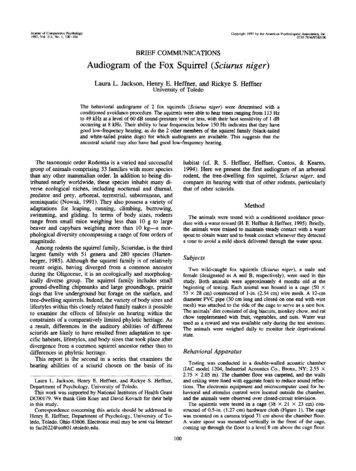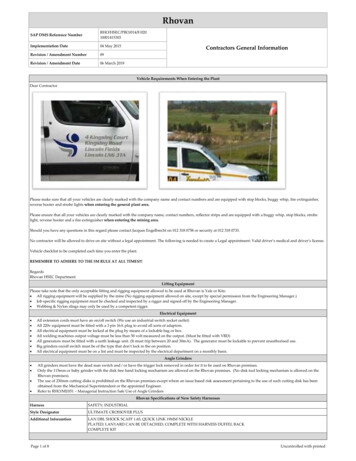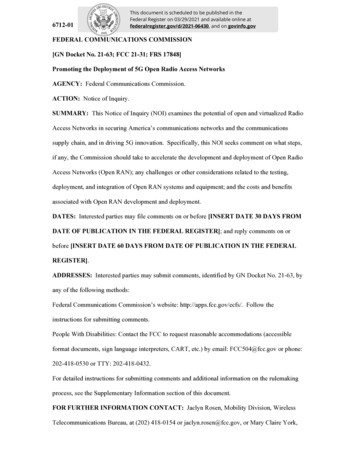
Transcription
Journal of Comparative Psychology1997, Vol. 111, No. 1, 1130-104Copyright 1997 by the American Psychological Association, Inc.0735-7036/97/ 3.00BRIEFCOMMUNICATIONSAudiogram of the Fox Squirrel(Sciurus niger)L a u r a L. J a c k s o n , H e n r y E. H e f f n e r , a n d R i c k y e S. H e f f n e rUmversity of ToledoThe behavioral audiograms of 2 fox squirrels (Sciurus niger) were determined with aconditioned avoidance procedure. The squirrels were able to hear tones ranging from 113 Hzto 49 kHz at a level of 60 dB sound-pressure level or less, with their best sensitivity of 1 dBoccurring at 8 kHz. Their ability to hear frequencies below 150 Hz indicates that they havegood low-frequency hearing, as do the 2 other members of the squirrel family (black-tailedand white-tailed prairie dogs) for which audiograms are available. This suggests that theancestral sciurid may also have had good low-frequency hearing.The taxonomic order Rodentia is a varied and successfulgroup of animals comprising 33 families with more speciesthan any other mammalian order. In addition to being distributed nearly worldwide, these species inhabit many diverse ecological niches, including nocturnal and diurnal,predator and prey, arboreal, terrestrial, subterranean, andsemiaquatic (Nowak, 1991). They also possess a variety ofadaptations for leaping, running, climbing, burrowing,swimming, and gliding. In terms of body sizes, rodentsrange from small mice weighing less than 10 g to largebeaver and capybara weighing more than 10 k g - - a morphological diversity encompassing a range of four orders ofmagnitude.Among rodents the squirrel family, Sciuridae, is the thirdlargest family with 51 genera and 280 species (Hartenberger, 1985). Although the squirrel family is of relativelyrecent origin, having diverged from a common ancestorduring the Oligocene, it is an ecologically and morphologically diverse group. The squirrel family includes smallground-dwelling chipmunks and large groundhogs, prairiedogs that live underground but forage on the surface, andtree-dwelling squirrels. Indeed, the variety of body sizes andlifestyles within this closely related family makes it possibleto examine the effects of lifestyle on hearing within theconstraints of a comparatively limited phyletic heritage. Asa result, differences in the auditory abilities of differentsciurids are likely to have resulted from adaptation to specific habitats, lifestyles, and body sizes that took place afterdivergence from a common squirrel ancestor rather than todifferences in phyletic heritage.This report is the second in a series that examines thehearing abilities of a sciurid chosen on the basis of itshabitat (cf. R. S. Heffner, Heffner, Contos, & Kearns,1994). Here we present the first audiogram of an arborealrodent, the tree-dwelling fox squirrel, Sciurus niger, andcompare its hearing with that of other rodents, particularlythat of other sciurids.MethodThe animals were tested with a conditioned avoidance procedure with a water reward (H. E. Heffner & Heffner, 1995). Briefly,the animals were trained to maintain steady contact with a waterspout to obtain water and to break contact whenever they detecteda tone to avoid a mild shock delivered through the water spout.SubjectsTwo wild-caught fox squirrels (Sciurus niger), a male andfemale (designated as A and B, respectively), were used in thisstudy. Both animals were approximately 4 months old at thebeginning of testing. Each animal was housed in a cage (50 X55 X 28 cm) constructed of 1-in. (2.54 cm) wire mesh. A 12-cmdiameter PVC pipe (30 cm long and closed onone end with wiremesh) was attached to the side of the cage to serve as a nest box.The animals' diet consisted of dog biscuits, monkey chow, and ratchow supplemented with fruit, vegetables, and nuts. Water wasused as a reward and was available only during the test sessions.The animals were weighed daily to monitor their deprivationalstate.Behavioral ApparatusTesting was conducted in a double-walled acoustic chamber(IAC model 1204, Industrial Acoustics Co., Bronx, NY; 2.55 2.75 2.05 m). The chamber floor was carpeted, and the wallsand ceiling were lined with eggcrate foam to reduce sound reflections. The electronic equipment and microcomputer used for behavioral and stimulus control were located outside the chamber,and the animals were observed over closed-circuit television.The squirrels were tested in a cage (38 X 21 X 23 cm) constructed of 0.5-in. (1.27 era) hardware cloth (Figure 1). The cagewas mounted on a camera tripod 71 cm above the chamber floor.A water spout was mounted vertically in the front of the cage,coming up through the floor to a level 8 cm above the cage floor.Laura L. Jackson, Henry E. Heffner, and Rickye S. Heffner,Department of Psychology, University of Toledo.This work was supported by National Institutes of Health GrantDC00179. We thank Gim Koay and David Kovach for their helpin this study.Correspondence concerning this article should be addressed toHenry E. Heffner, Department of Psychology, University of Toledo, Toledo, Ohio 43606. Electronic mail may be sent via Internetto fac2622 @uoft01.utoledo.edu.100
BRIEF COMMUNICATIONSFigure 1. Diagram illustrating the arrangement of the behavioraltest apparatus (not to scale).The water spout consisted of a brass tube (3 rnm outer diameter)with an oval brass disk (2 cm 2.5 cm) mounted on the top of thespout at a 50 angle sloping down toward the animal. This arrangement allowed the animal to face the front of the cage andhold its head in a normal posture while drinking from the waterspout. The water spout was connected by plastic tubing to asyringe pump located outside the chamber. A contact switch connected between the spout and the cage floor indicated when asquirrel was in contact with the spout and activated the syringepump. Thus, the squirrels received a steady trickle of water whenever they were in contact with the water spout. They typicallyreceived 35-40 mi of water in a session lasting 60-90 min.A mild electric shock was delivered by a constant-current shockgenerator connected between the water spout and the cage floor.The duration of the shock pulse was 0.3 s, and the squirrel couldescape it by breaking contact with the spout. The delivery of theshock was accompanied by turning on a 15-watt light bulb locatedbeneath the front of the cage--the light thus served as a signal thatthe shock was being delivered, and turning it off signalled that theshock was over and the squirrel could return to the spout.Acoustical ApparatusSine waves were generated by a signal generator (Krohn-Hite2400, Krohn-Hite, Avon, MA), which was calibrated daily with afrequency counter (Fluke 1900A, John Fluke Manufacturing, Seattle, WA). The electrical signal was gated on and off with arise-fall gate (Coulbourn 84-04, Coulborn, Lehigh Valley, PA),bandpass filtered at one-third octave centered on the test frequency(Krohn-Hite 3550 filter, Krohn-Hite, Avon, MA), attenuated(Hewlett Packard 350D, Hewlett Packard, Loveland, CO), andconnected by an amplifier (Adcom GFA 545, Adcom, East Brunswick, NJ) to a loudspeaker. The electrical signal to the loudspeakerwas monitored with an oscilloscope. A loudspeaker was placedapproximated 1.0 m in front of the cage and oriented toward theposition occupied by the squirrel's head when it was drinking from101the water spout. The distance of the loudspeaker was varied by asmuch as 0.5 m as needed to achieve an even sound field ofsufficient intensity around the squirrel's head. The loudspeakersused included a 15-in. (38-cm) woofer for 63 Hz to 8 kHz, and aribbon tweeter for 8 kHz to 56 kHz. Pure-tone thresholds wereobtained at octave intervals ranging from 63 Hz to 32 kHz, withadditional thresholds at 45, 50, and 56 kHz. The tones were pulsed,400 ms on and 100 ms off for 4 pulses, with rise-fall times of 100ms for 63 Hz, 40 ms for 250 Hz, 20 ms for 500 Hz, and 10 ms forfrequencies of 1 kHz and higher. The sound-pressure level (SPL re20/ N/m2) was measured daily with a .25-in. (.64 cm) microphone(Brtiel & Kjaer 4135, Briiel & Kjaer, Naerum, Denmark), microphone amplifier (Briiel & Kjaer 2608, Briiel & Kjaer, Naerum,Denmark), and filter (Krohn-Hite 3202, Krohn-Hite, Avon, MA)set to pass one octave above and below the test frequency. Themeasuring system was calibrated with a pistonphone (Brtiel &Kjaer 4230, Brtiel & Kjaer, Naerum, Denmark). Sound measurements were taken by placing the microphone in the positionoccupied by the squirrel's head and pointing it directly toward theloudspeaker (0 incidence). Care was taken to produce a homogenous sound field (--- 1 dB) in the area occupied by the squirrel'shead and ears while it was drinking from the spout. As a precautionagainst transmission of low-frequency substrate vibrations to thesquirrels through the floor, thick foam was placed under the 15-in.woofer used for low-frequency testing. In addition, the linearity ofthe attenuator was verified over the range of attenuation used forthreshold testing at each frequency by measuring its output voltageand the resulting sound pressure level.Psychophysical ProcedureA thirsty squirrel was placed in the test cage and allowed todrink from the water spout. Tones were presented at randomintervals and followed at their offset by mild electric shock delivered through the spout. The squirrels quickly learned to avoid theshock by breaking contact with the spout whenever they heard atone. The shock was adjusted for each individual to the lowestlevel that would reliably produce an avoidance response. Themildness of the shock was attested by the fact that neither squirreldeveloped a fear of the spout; both returned to it without hesitationafter a shock had been delivered.Test sessions were divided into 2.0-s trials separated by 1.5-sintertrial intervals. Each trial contained either a pulsing tone (thewarning signal) or silence (the safe signal), with 22% of the trialscontaining a tone. A response was recorded if a squirrel brokecontact for more than half of the last 150 ms of a trial (asdetermined by the microcomputer). The response was classified asa hit if the trial contained a tone and as a false alarm if no tone hadbeen presented. Both the hit and false-alarm rates were determinedfor each block of 6 - 8 warning trials (which also included approximately 25 safe trials) for each stimulus condition. The hit rate wascorrected for false alarms according to the following formula:performance hit rate - (false-alarm rate hit rate), with the hitand false-alarm rates expressed as percentages. This measure proportionately reduces the hit rate by the false-alarm rate observedunder each stimulus condition and varies from 0 (no hits) to 1(100% hit rate and 0% false-alarm rate).Absolute thresholds were determined by reducing the intensityof a tone in successive blocks of 6 - 8 warning trials until thesquirrel no longer responded to the signal above the .01 chancelevel (binomial distribution). Once a preliminary threshold hadbeen obtained, final threshold determination was conducted bypresenting tones varying in intensity in 5-dB increments extendingfrom 10 dB below to at least 10 dB above the estimated threshold.
102BRIEF COMMUNICATIONSThreshold was def'med as the intensity corresponding to a performance of .50. Threshold testing for a particular frequency wasconsidered complete when the thresholds obtained in at least twodifferent sessions were within 3 dB of each other. Once an audiogram had been completed, each threshold was rechecked to ensurereliability.ResultsThe avoidance task was an easy one for the squirrels tolearn, and they were reliably avoiding the shock within thefirst session. The squirrels trained quickly and were givingreliable and valid thresholds within 3-10 sessions. Moreover, the squirrels worked steadily for 60-120 rain withoutmisses or false alarms at easily detectable intensities. Ourimpression is that squirrels are better subjects for psychophysical experiments than most other rodents, includinglaboratory rats, because of their quick learning and consistently perfect performance on suprathreshold stimuli. Theaudiograrns of the two squirrels are shown in Figure 2.Beginning at the low frequencies, the squirrels were able tohear 63 Hz with an average threshold of 79 dB SPL andwith sensitivity improving as frequency was increased. Thesquirrels showed a broad range of good sensitivity extending from 500 Hz to 32 kHz, with their best threshold of 1 dBat 8 kHz. Above 32 kHz, their sensitivity decreased rapidly,with Squirrel A able to hear 50 kHz at a level of 69 dB andSquirrel B able to hear as high as 56 kHz at a level of 85 dB.Overall, at an intensity of 60 dB, the average range ofhearing for the two squirrels, extended from 113 Hz to49 kHz.DiscussionHearing in RodentsThe addition of the fox squirrel brings the total number ofrodents for which behavioral audiograms are available to17. In making comparisons among rodents, we have cometo classify them into one of three groups based on theirFox Squirrel Audiogram1O0 . 90 C E 80Z . 7 0 oeq 60-'10m 50. 4 0 "1o 3020 10--10-.- / , . .B ,, . B/ ." -IIIIiII Ia da 2s 2so so0 k k k 8k 16k a2k 64k128kFrequency (in Hz)Figure 2. Absolute thresholds of two fox squirrels (A and B).Dashed line indicates the 60-dB sound-pressure level.hearing abilities: good low-frequency hearing, poor lowfrequency hearing, and degenerate hearing. The good lowfrequency rodents are those with the ability to hear below150 Hz at an intensity of 60 dB while retaining goodhigh-frequency heating. These are the chinchilla, gerbil,guinea pig, and kangaroo rat (H. E. Heffner & Masterton,1980; R. S. Heffner & Heffner, 1991; R. S. Heffner, Heffner, & Masterton, 1971; Ryan, 1976). The poor lowfrequency rodents are those whose 60-dB low-frequencycutoff is above 500 Hz. These rodents tend to be smaller andto have slightly better high-frequency hearing than thosewith good low-frequency hearing--a finding consistentwith the inverse relationship between interaural distanceand high-frequency hearing that has been observed in mammals (e.g., R. S. Heffner & Heffner, 1992). These rodentsinclude the cotton rat, grasshopper mouse, domestic housemouse, wild house mouse, albino Norway rat, pigmentedNorway rat, and wood rat (H. E. Heffner & Heffner, 1985;H. E. Heffner, Heffner, Contos, & Ott, 1994, H. E. Heffner& Masterton, 1980; Kelly & Masterton, 1977; Markl &Ehret, 1973). Finally, the third group consists of rodentswith degenerate hearing and includes the blind mole rat,naked mole rat, and pocket gopher (R. S. Heffner & Heffner, 1990, 1992, 1993). The range of auditory sensitivitiesfor each of these groups is shown by the shaded areas inFigure 3.In making this classification, the question arises as towhat ecological, anatomical, or phylogenetic factors mayaccount for the three groupings. In the case of the rodentswith degenerate hearing, it can be seen that they share acommon habitatwthe blind mole rat, naked mole rat, andpocket gopher are all subterranean rodents. Undergroundburrows provide a very different acoustic environment thanabove-ground habitats, and we have noted elsewhere thatanimals adapted exclusively to an underground habitat losemuch of their overall sensitivity and high-frequency hearingdue in part to the apparent absence of selective pressure tolocalize brief sounds (R. S. Heffner & Heffner, 1990, 1992,1993). With regard to the other two groups, the use of 150Hz to define good and poor low-frequency rodents is basedon an apparent gap in the distribution of mammalian lowfrequency cutoffs. In a sample of 61 mammals (excludingthose adapted to underwater hearing), we have found thatthe lowest frequencies audible at a level of 60 dB are evenlydistributed with the exception of a 1.75-octave gap between150 Hz and 500 Hz (the probability of such a gap occurringby chance is p .001, Monte Carlo method; cf. Simon,1992). There currently is no recognized factor that canexplain why some rodents (or mammals in general) havebetter low-frequency hearing than others. That is, thereappears to be no ecological or phylogenetic basis for thisgrouping. Nor is there any obvious anatomical basis-although it appears that the enlarged bullae of the kangaroorats and gerbils is a morphological adaptation for lowfrequency hearing (Webster & Webster, 1984), not all mammals with good low-frequency hearing possess this specialization (R. S. Heffner et al., 1994). One alternative is thatthese two groups may simply represent two ends of acontinuum, with the possibility that future studies may
BRIEF COMMUNICATIONS103reveal rodents whose heating falls intermediate to them.However, this distinction is currently useful as a reminderthat the heating ability of rodents is quite varied and thatrodent hearing cannot be adequately represented by a singlespecies, such as the laboratory rat.Comparison of Fox Squirrels With Other RodentsThe audiogram of the fox squirrel is compared with eachof the three groupings of rodents in Figure 3. As shown inthe top graph of Figure 3, the ability of the fox squirrel tohear below 150 Hz at a level of 60 dB places it with thegood low-frequency rodents. Although its low-frequencyheating is not as good as the four species represented by theshading, or the two species of prairie dogs also shown inFigure 3 (indicated by the letters B and W), the squirrelhears nearly 2 octaves lower than the high-frequency rodents (middle graph of Figure 3). In addition, its highfrequency hearing is within the range of the other lowfrequency rodents. Thus, it appears that the fox squirrelbelongs among the low-frequency rodents.Hearing in SciuridsFigure 3. Average fox squirrel audiogram (S) compared withthe audiograms of other rodents, black-tailed prairie dogs (B;Cynomys ludovicianua), and white-tailed prairie dogs (W; Cynomys leucurus). Horizontal dashed lines indicate 60-dB soundpressure level. See text for references to individual andiograrns.Top: Shading indicates rodents with good low-frequency hearing--chinchilla (Chinchilla laniger), gerbil (Meriones unguiculatis), guinea pig (Cavia porcellus), and kangaroo rat (Dipodomysmerriami). Middle: Shading indicates rodents with poor lowfrequency hearing--albino and pigmented rat (Rattus norvegicus),A comparison of the fox squirrel with the two othersciurids for which data are available, the black-tailed andwhite-tailed prairie dogs (R. S. Heffner et. al., 1994), reveals both similaritiesand differences. Prairie dogs, likesquirrels,fallinto the good low-frequency group of rodents(cf. Figure 3). This finding raises the possibilitythat theancestral sciurid was also a good low-frequency animal, apoint that will require the examination of additionalsciuridsbefore it can be accepted. Fox squirrels and prairie dogsdifferon two important parameters: high-frequency hearingand absolute sensitivity. In terms of the 60-dB highfrequency cut-off,fox squirrelsbear up to 56 kHz whereasprairie dogs hear only as high as 26 kHz, a difference ofslightly more than an octave. This difference is notablebecause there is an inverse relationshipbetween interanraldistance and high-frequency hearing, which would predictthat, if anything, prairie dogs with their slightly smallerinteraural distance should have somewhat better highfrequency bearing than fox squirrels (H. E. Hcffner &Hcffncr, 1985). In addition, prairie dogs are far less sensitive than fox squirrels,with theirbest sensitivityof 20-24dB contrasting with the fox squirrels'best sensitivityof ldB. The bottom graph in Figure 3 shows that the comparativelypoor absolute sensitivityand high-frequency hearingof the prairie dogs place them intermediate between foxsquirrels and subterranean rodents. Although prairie dogsare not subterranean animals, they do spend much of theirwild and domestic house mouse (Mus musculus), cotton rat (Sigmodon hispidus), grasshopper mouse (Onychomys leucogaster),and wood rat (Neotoma floridana). Bottom: Shading indicatessubterranean rodents with degenerate hearing--blind mole rat(Spalax ehrenbergi), naked mole rat (Heterocephalus glaber), andpocket gopher (Geomys bursarius).
104BRIEF COMMUNICATIONStime in underground burrows. This suggests that the hearingof prairie dogs may be an intermediate adaptation betweensurface-dwelling and subterranean rodents. It also suggeststhat good absolute sensitivity and high-frequency hearingare either not necessary for, or else are somehow incompatible with, an underground lifestyle. Thus, although the recent common ancestry of the fox squirrel and the prairie dogmay be responsible for the fact that they all have goodlow-frequency heating, the differences in absolute sensitivity and high-frequency hearing may be the result of divergent adaptations to different lifestyles. These differences inclosely related animals indicate that hearing range and sensitivity are relatively plastic behavioral traits. An identification of the selective pressures that lead to such differencesshould provide insight into the evolution of mammalianhearing.ReferencesHartenberger, J.-L. (1985). The order Rodentia: Major questionson their evolutionary origin, relationships and suprafamilial systematics. In W. P. Luckett & J.-L. Hartenberger (Eds.), Evolutionary relationships among rodents. (pp. 1-34). New York:Plenum.Heffner, H. E., & Heffner, R. S. (1985). Hearing in two cricetidrodents: Wood rat (Neotoma floridana) and grasshopper mouse( Onychomys leucogaster). Journal of Comparative Psychology,99, 275-288.Heffner, H. E., & Heffner, R. S. (1995). Conditioned avoidance. InG. M. Klump, R. J. Dooling, R. R. Fay, & W. C. Stebbins (Eds.),Methods in comparative psychoacoustics (pp. 73-87). Basel,Switzerland: Birkh user.Heffner, H. E., Heffner, R. S., Contos, C., & Ott, T. (1994).Audiogram of the hooded Norway rat. Hearing Research, 73,244-247.Heffner, H. E., & Masterton, B. (1980). Hearing in glires: Domestic rabbit, cotton rat, feral house mouse, and kangaroo rat.Journal of the Acoustical Society of America, 68, 1584-1599.Heffner, R. S., & Heffner, H. E. (1990). Vestigial hearing in afossorial mammal, The pocket gopher (Geomys bursarius).Hearing Research, 46, 239-252.Heffner, R. S., & Heffner, H. E. (1991). Behavioral hearing rangeof the chinchilla. Hearing Research, 52, 13-16.Heffner, R. S., & Heffner, H. E. (1992). Heating and soundlocalization in blind mole rats. Hearing Research, 62, 206-216.Heffner, R. S., & Heffner, H. E. (1993). Degenerate hearing andsound localization in naked mole rats (Heterocephalus glaber),with an overview of central auditory structures. Journal ofComparative Neurology, 331, 418-433.Heffner, R. S., Heffner, H. E., Contos, C., & Kearns, D. (1994).Hearing in prairie dogs: Transition between surface and subterranean rodents. Hearing Research, 73, 185-189.Heffner, R. S, Heffner, H. E., & Masterton, B. (1971). Behavioralmeasurements of absolute and frequency difference thresholdsin guinea pig. Journal of the Acoustical Society of America, 4,1888-1895.Kelly, J. B., & Masterton, R. B. (1977). Auditory sensitivity of thealbino rat. Journal of Comparative and Physiological Psychology, 91, 930-936.Markl, H., & Ehret, G. (1973). Die H6rschwelle der maus (Musmusculus) [The auditory thmshhold of the mouse (Mus musculus)]. Zeitschrifl far Tierpsychologie, 33, 274-286.Nowak, R. M. (1991). Walker's mammals of the worm (5th ed.,Vols. 1-2). Baltimore, MD: Johns Hopkins University.Ryan, A. (1976). Hearing sensitivity of the Mongolian gerbilMeriones unguiculatis. Journal of the Acoustical Society ofAmerica, 59, 1222-1226.Simon, J. L. (1992). Resampling: The new statistics. Belmont, CA:Duxbury Press.Webster, D. B., & Webster, M. (1984). The specialized auditorysystem of kangaroo rats. In W. D. Neff (Ed.), Contributions tosensory physiology (Vol. 8, pp. 161-196). New York: AcademicPress.Received February 20, 1996Revision received June 4, 1996Accepted June 10, 1996
The behavioral audiograms of 2 fox squirrels (Sciurus niger) were . adaptations for leaping, running, climbing, burrowing, . rodents range from small mice weighing less than 10 g to large beaver and capybara weighing more than 10 kg--a mor- phological diversity encompassing a range of four orders of magnitude. Among rodents the squirrel .










